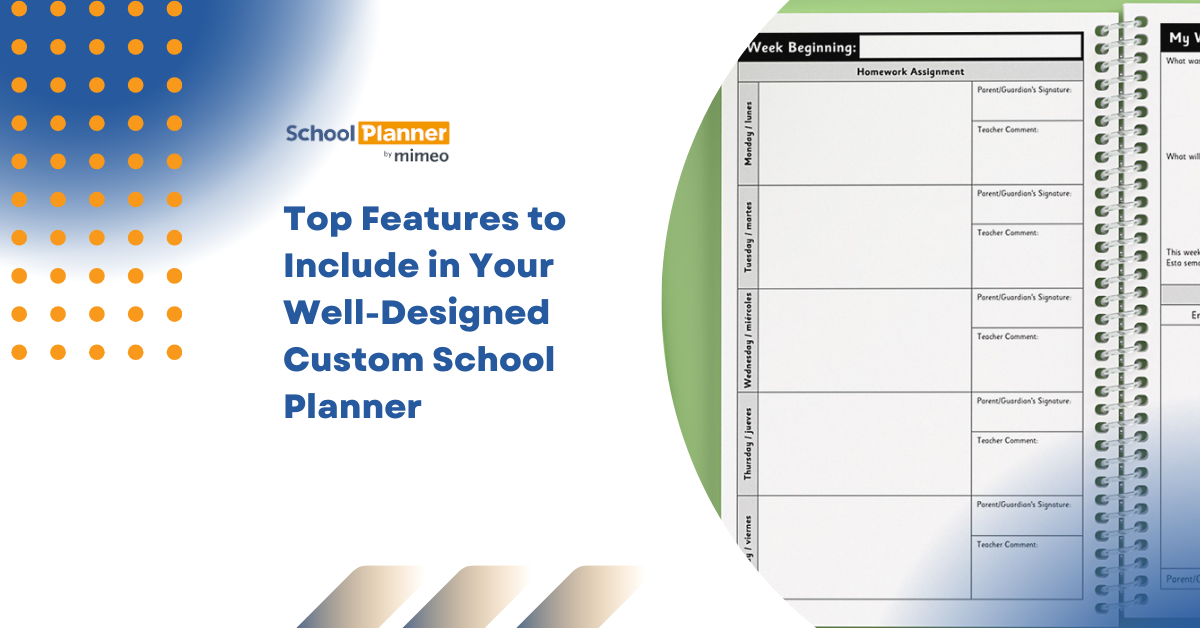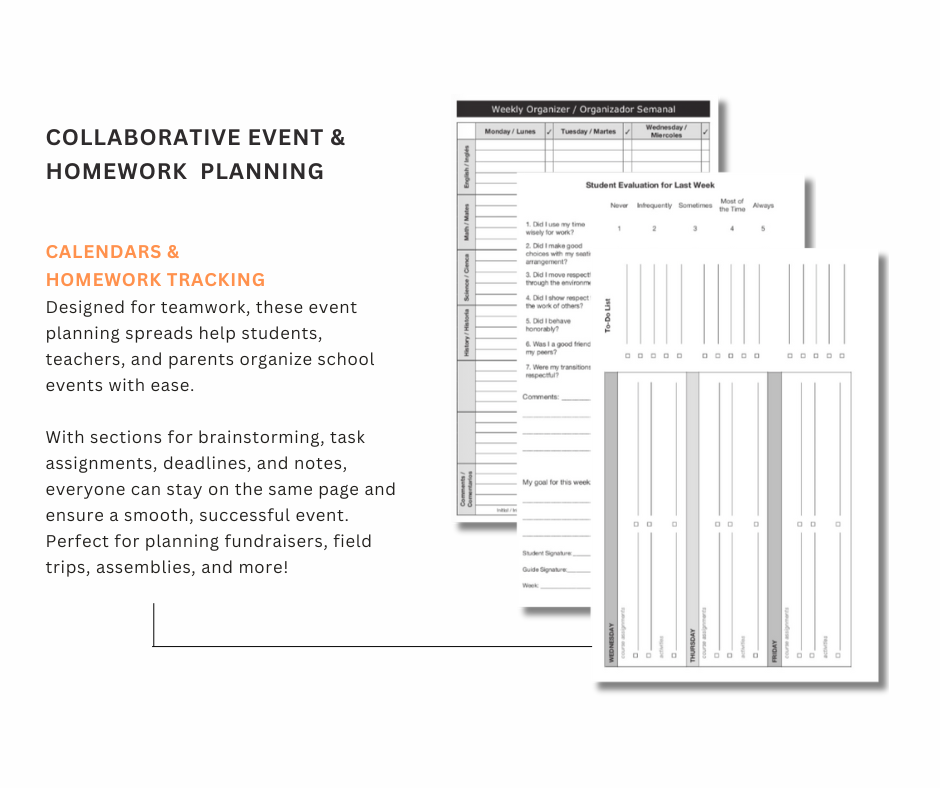A well-designed custom school planner is more than just a notebook; it’s a productivity powerhouse that helps students, teachers, and parents stay organized and focused. To ensure your custom school planner meets the needs of your community, here are the top features to include for maximum productivity.

1. Well-designed custom school planners include a personalized cover and school branding.
Research is clear: first impressions matter.
A custom cover featuring your school’s logo, colors, and motto not only promotes school pride but also ensures that the planner feels tailored to your community. Add personalization options, like a student’s name or grade level, for an extra-special touch.
2. Well-designed custom school planners consider weekly, monthly, and annual views for maximum productivity.
When making a custom school planner, it’s crucial to incorporate a variety of calendar views—weekly, monthly, and annual—to support maximum productivity for both students and teachers. A comprehensive planner doesn’t just capture the day-to-day; it provides a big-picture overview of the academic year while breaking tasks down into manageable steps. Each calendar view plays a distinct role in helping users stay organized, whether they’re tracking long-term projects, planning lessons, or balancing extracurricular activities.
Comprehensive calendars are essential for staying on track.
| Calendar Type | Description | Purpose |
|---|---|---|
| Yearly Overview | Highlights key dates such as holidays, exams, and school events at a glance. | Long-term planning and awareness of major milestones throughout the academic year. |
| Monthly Calendars | Provides ample space to note long-term projects, upcoming deadlines, and scheduled events. | Mid-range planning and project management. |
| Weekly Layouts | Breaks down tasks day by day, with space for notes, to-do lists, and short-term goals. | Day-to-day organization and task tracking. |
| Bonus Tip: Color-Coded Sections | Use different colors to distinguish between academic subjects, activities, or task types. | Makes the schedule visually intuitive and easy to navigate quickly. |
The annual view offers a bird’s-eye perspective of the entire school year, highlighting important dates like holidays, exam periods, and major school events. This allows teachers to map out curriculum pacing and students to anticipate key milestones. Monthly calendars zoom in slightly, giving users a chance to outline upcoming assignments, tests, and activities with more detail. These monthly pages serve as a helpful bridge between the distant future and the immediate week, helping prevent last-minute surprises or forgotten deadlines.
Weekly layouts are the heart of daily productivity. They break tasks down into bite-sized chunks and give students and teachers space to plan each day intentionally. Whether it’s jotting down homework, creating lesson plans, or listing to-do items, weekly spreads ensure users always have clarity about what’s next. By thoughtfully including all three calendar views when making a custom school planner, schools equip their communities with a versatile tool that fosters both short-term focus and long-term success.
READ MORE: Most Requested Custom Planner Templates This Year

3. Well-designed custom school planners include space for goal tracking.
Help students stay on top of their workload with dedicated sections for tracking homework, assignments, and projects. Include spaces to note due dates, required materials, and completion status to encourage accountability and time management.
Our Favorite Goal-Tracking Templates

Including goal-setting pages when making a custom school planner is a powerful way to inspire students to strive for their best—both in and out of the classroom. By giving students dedicated space to articulate their aspirations, planners help them reflect on where they are and where they want to go. These sections encourage a growth mindset by helping students break larger goals into achievable steps, whether it’s improving their math grades, learning a new hobby, or preparing for college. A well-structured goal-setting page makes ambitions feel more tangible and attainable.
To make these sections even more effective, consider adding checklists and progress trackers that let students visualize their achievements along the way. Simple tracking tools can boost motivation, helping students stay focused and celebrate milestones as they move forward. When designing a custom school planner, balancing academic, personal, and long-term goals ensures that students grow holistically, fostering not only academic success but also personal development and future readiness.
| Goal Type | Examples | Purpose |
|---|---|---|
| Academic Goals | Improve math grades, read more books, complete science fair project | Encourage stronger study habits and academic achievement |
| Personal Goals | Develop a new hobby, practice mindfulness, volunteer in the community | Support personal growth and emotional well-being |
| Long-term Ambitions | Research colleges, explore career interests, apply for scholarships | Foster future planning and readiness for life after school |
4. Well-designed custom school planners consider the bond between the home and the classroom.
Strengthen the school-home connection by including spaces for teacher-parent communication. These logs can be used to:
- Share updates about a student’s progress.
- Provide reminders about upcoming events.
- Address questions or concerns in a structured way.

Maximize Productivity with a Well-Designed Custom School Planner
Including these features in your custom school planner ensures that it becomes an indispensable tool for your students, teachers, and parents. By tailoring the design to your community’s needs, you’ll create a planner that fosters organization, communication, and success.
Interested in designing a custom planner for your school? Contact us today to get started or request a quote!